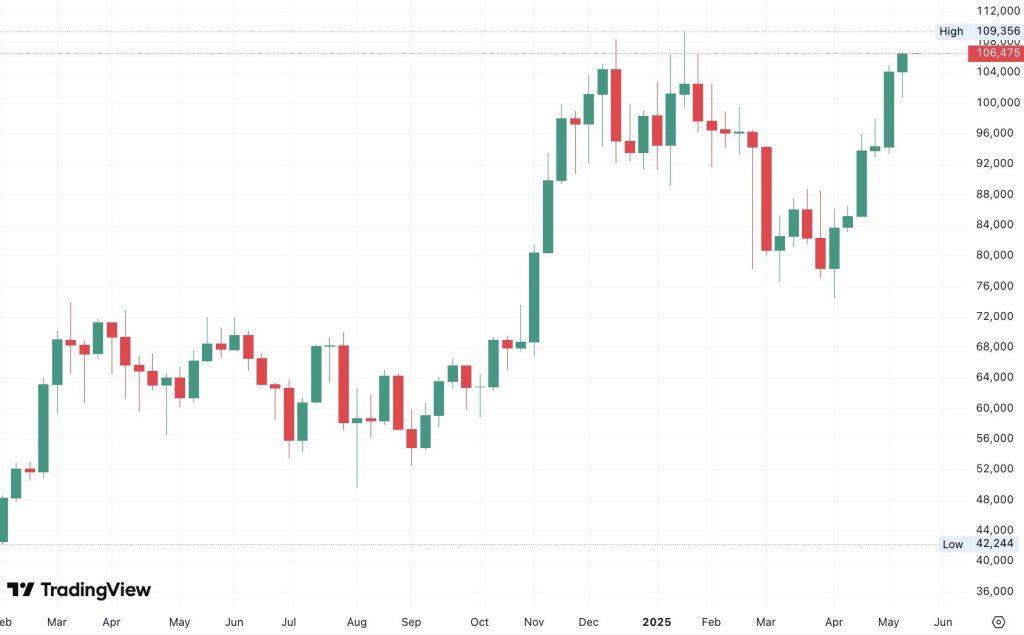Bitcoin reached its highest-ever weekly close at $106,516 on May 18, 2025, sitting just 3% below its all-time high of $109,358 from January. This marks Bitcoin’s sixth straight week of gains, with big investors and economic uncertainty driving new interest in the digital currency.
Major financial companies, especially BlackRock’s iShares Bitcoin Trust, invested more than $608 million into U.S. spot Bitcoin ETFs just last week. In the first half of May, total investments exceeded $2.8 billion, with ETF assets now over $122 billion.
Bitcoin’s close above $106,000 represents a rare achievement in its history. According to on-chain researcher Dan, Bitcoin has closed above $106,439 only once before—making up just 0.02% of its trading history. Prices have exceeded $100,000 on only 40 days total.

Source: TradingView
Market trends suggest Bitcoin might be following a pattern similar to November 2024, when it jumped about $30,000 over three weekly periods. So far this month, Bitcoin has climbed roughly $12,000, moving from $94,000 to over $106,000 before settling around $105,400.
Supply-demand imbalance driving prices
Matt Hougan, Chief Investment Officer at Bitwise, points to a clear supply-demand mismatch. Miners will produce only about 165,000 new bitcoins in 2025, but companies and ETFs have already bought more than that amount.
Analyst Willy Woo wrote on social media: “BTC is now traded as the newest macro asset in 150 years, it’ll continue to absorb capital until it reaches equilibrium.”
Woo compared Bitcoin’s future growth potential to long-term money supply expansion of 5% and economic growth of 3%. He predicted Bitcoin’s yearly growth rate might stabilize around 8% in the next 15 to 20 years. “Until then, enjoy the ride because almost no publicly investable product can match BTC performance long term, even as BTC’s CAGR continues to erode,” he added.
Macroeconomic factors at play
The rally happens amid changing economic signals. A temporary 90-day tariff reduction between the U.S. and China has helped somewhat, but high taxes remain on electric vehicles, computer chips, and consumer electronics.
The credit rating agency Moody’s recently downgraded the U.S. government from AAA to AA1, warning about growing government debt and wider budget deficits. With inflation worries continuing, investors seem to be turning to Bitcoin as a possible hedge against rising prices.
Bitcoin’s next major target is breaking through its January peak of $109,358. However, analyst Bluntz has spotted a bearish divergence on the daily chart that could slow Bitcoin’s rise. This happens when price makes a higher high but technical indicators show weakening momentum, suggesting buying pressure might be fading despite rising prices.
Whether Bitcoin will keep going up or face resistance remains to be seen. Right now, institutional investments and economic uncertainty are the main forces driving the market as more people start using cryptocurrency.



















